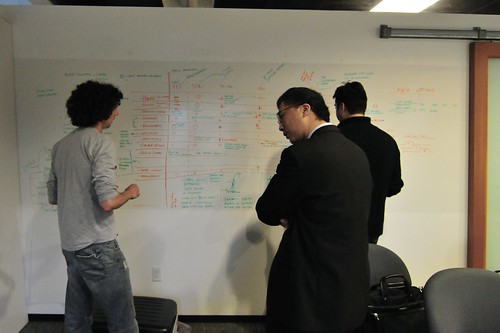A worthwhile challenge for designers — learn how to learn. Self-evident, but I’m just sayin’. Learning the particulars of the mechanics, engineering, materials — what is often waved-off as “technology” — of the objects designed has more value than one might think at first. It’s a bit brutal at times, and daunting, and confusing. Just when you think you understand what the implications are of displays that use TFT, you realize you’ve got it all backwards. In the end, though, it gets figured out.
The advantages are that questions and parameters integral to one’s own perspective on the design get highlighted and discussed. Perhaps even new processes are introduced, even new approaches to creating the “technology”, merely based on a different perspective that engineers, marketers and others had never really considered relevant.
Here, above, the motivation for this design process thought. Our languages about display parameters initially stuck to the usual categories. In particular, we talked about “contrast.” The engineers had an existing, instrumental and mathematical perspective on what contrast is — a dynamic range between white and black. This is correct, of course. Duncan added a new parameter — “punchiness.” A new bit of language to the conversation about displays. Less instrumental, but valid because, in a way, perhaps unexpectedly, he was referring to the perception that people who have to use the display might have of the display’s characteristics. Something more people oriented than even “contrast.”
Why do I blog this? I’m curious about what happens when different practice communities come together. How does their thinking shift? How is language and gesture deployed to explain ideas and idioms that are not shared?
For example, during this get-together, the room was shared by designers, technical managers, engineers — six of us all together. There were three formal languages spoken — German, English and Japanese. There were several technical languages spoken, some specific and articulate, others broken and pidgin — materials technology, optics, electrical engineering, manufacturing technology, industrial manufacturing, industrial design, chemistry, ecology. There were some interesting extended hand gestures to indicate processes, actions and activities, all in the interest of sharing ideas and developing insights and learning and breaking down the usual disciplinary boundaries to find new vantage points from which to create new things. Part of that means, learning at least a bit about what these various languages have to say about and contribute to the design process. Design without a depth of knowledge about the materials/processes/histories one is designing with is the definition of disadvantage. To the degree that knowledge is shallow, or nonexistent is equal to the degree of disadvantage one has. (Really, time spent on the assembly line, in the design studio, in the materials lab, the clean rooms, hearing about failures — all of this is necessary to attain that depth, and the consequent advantage to design processes.)
It should be expected (if it isn’t already) that it’s not enough for a designer to pay attention only to surface and appearance. Part of the robustness of design comes from understanding the possibilities of new materials, new processes, new processors, or having the language, practice skills and moxy to suggest new possible engineering (say) processes or whole new technologies based on a unique insight that runs not just broad, but deep. As I once told students, it’s not easy, or fast, or possible to do so from day one after graduating. It’s a lifetime process to develop a breadth and depth of knowledge and practice that can make new things. That means patience, a keen eye, eager will and an aspiration to learn in every context, not just the classroom. The best thing you can get for your educational dollar is to learn how to learn.
